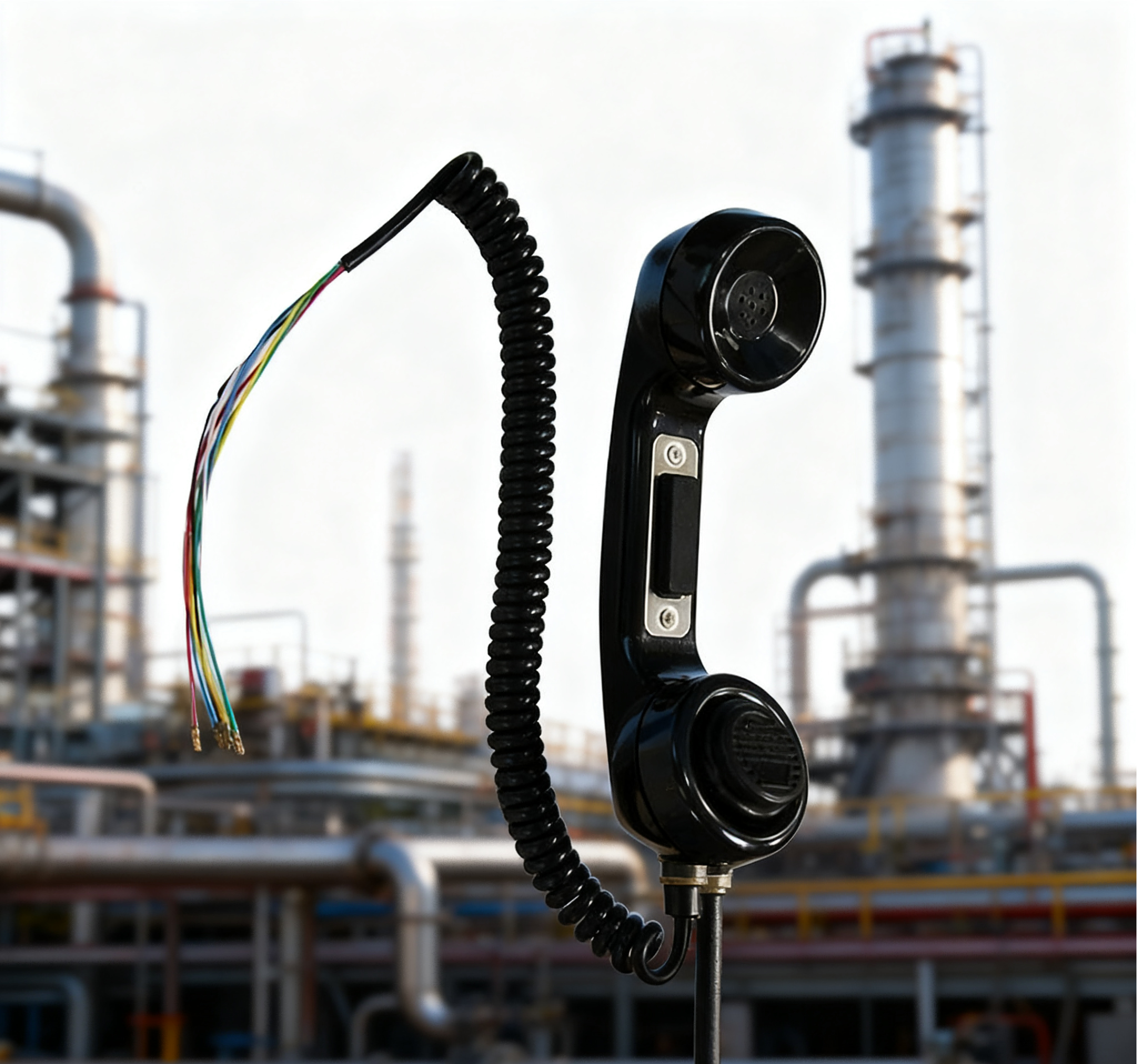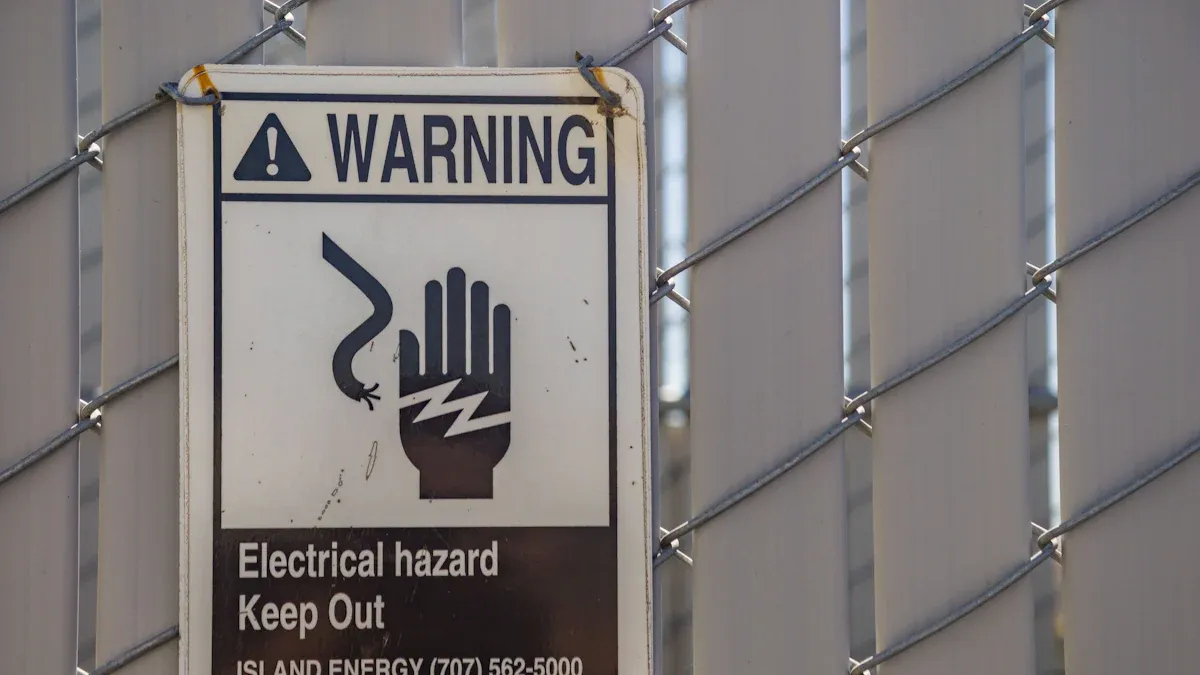
Working in petrochemical plants carries high risks. Safety is always paramount. Ineffective communication often causes incidents in the oil and gas sector. Over 60% of executives believe communication breakdowns contribute to up to a quarter of safety incidents. An Explosion-Proof Handset is crucial for clear, reliable communication, directly preventing these dangerous situations.
Key Takeaways
- Choose handsets with the right safety certifications for your plant’s hazardous zones.
- Select durable handsets that resist dust, water, impacts, and chemicals for reliable use.
- Ensure handsets have clear voice quality, emergency features, and long battery life for worker safety.
1. Certification and Compliance for Explosion-Proof Handsets

Choosing the right communication device for a petrochemical plant starts with understanding safety certifications. These certifications ensure equipment can operate safely in dangerous atmospheres. Different regions have their own standards.
Understanding Global and North American Standards (ATEX, IECEx, UL/CSA)
You must know the specific safety standards for your plant’s location. ATEX is a European Union directive. UL and CSA are North American standards. IECEx is a global standard that helps harmonize international trade. Here is a quick look at ATEX and UL:
| Feature | ATEX | UL |
|---|---|---|
| Origin | European Union (EU) | United States (US) |
| Purpose | Ensures equipment for potentially explosive atmospheres meets health and safety rules. | Certifies products for safety, quality, and sustainability, including hazardous locations. |
| Legal Basis | Directive 2014/34/EU | Private, non-profit organization that sets standards and certifies. |
| Scope | Applies to electrical and non-electrical equipment in explosive atmospheres. | Certifies many products, including those for hazardous locations. |
| Focus | Prevents explosions and ensures worker safety. | Broader focus on overall product safety. |
While distinct, some products might have both ATEX and UL certifications. This helps them sell in different markets.
Matching Equipment Group and Protection Level to Hazardous Areas
Petrochemical plants divide hazardous areas into zones based on explosion risk. Each zone requires specific equipment. For example, Zone 0 has explosive gas present continuously. Zone 1 means explosive atmospheres are likely during normal work. Zone 2 means explosive gas is unlikely and only present for short times.
| Zone | Description | ATEX Category | Typical Protection Types |
|---|---|---|---|
| Zone 0 | Explosive gas present continuously or for long periods. | Category 1G | Ex ia (intrinsic safety), Ex ma (encapsulation) |
| Zone 1 | Explosive atmospheres likely in normal operation. | Category 2G | Ex d (flameproof), Ex e (increased safety), Ex p (pressurisation) |
| Zone 2 | Explosive gas atmospheres unlikely in normal operation. | Category 3G | Ex n, Ex ec |
You must select an Explosion-Proof Handset that matches the zone where workers will use it.
Assessing Enclosure Robustness and Material Construction
The handset’s outer casing must withstand harsh plant conditions. This includes corrosive chemicals and extreme temperatures. Strong materials protect the internal electronics.
Consider these materials for enclosures:
- Aluminum: It is lightweight and resists corrosion well. It also handles heat efficiently.
- Stainless Steel: This material is very strong. It resists corrosion from chemicals and saltwater. It ensures long life in tough environments.
- Non-Metallic Materials: Fiberglass Reinforced Polyester (FRP) and Polycarbonate are good choices. They resist corrosion, insulate electrically, and weigh less. They work well where metal might rust.
2. Durability and Environmental Resistance of Explosion-Proof Handsets

Petrochemical environments are tough. Handsets must survive daily challenges. They face dust, water, impacts, and chemicals. A durable handset ensures reliable communication when it matters most.
IP Rating for Dust and Water Ingress Protection
An Ingress Protection (IP) rating tells you how well a device resists dust and water. This rating is crucial for any equipment in a plant. For example, many explosion-proof telephones, like the JREX106-A03, have an IP66 rating. This means they offer strong protection against dust and powerful water jets. Some models, including certain intrinsically safe phones and SIP/VoIP handsets, even achieve an IP67 rating. This allows for temporary immersion in water, providing an extra layer of safety against spills or heavy rain.
Impact Resistance and Temperature Extremes
Handsets often drop or bump into things. They need to withstand these impacts. The EN 62262 (IEC 62262) standard helps evaluate how well equipment enclosures protect against mechanical impacts. This standard uses IK codes. For industrial settings, IK levels from IK05 to IK10 are important. Many specialized lighting products, for instance, require tests at IK07, IK08, IK09, and IK10. This ensures the device can handle significant force. Also, petrochemical plants experience wide temperature swings. An Explosion-Proof Handset must operate reliably in both extreme heat and cold.
Withstanding Chemical Exposure and Vibrations
Chemicals are everywhere in a petrochemical plant. Handset materials must resist corrosion and degradation from these substances. Different materials offer varying levels of protection:
| Material | Key Petrochemical Resistances |
|---|---|
| PVC | Fuel oil |
| Nitrile | Solvents, grease, oils, asphalt, gasoline, mineral oil, naphtha |
| Neoprene | Petroleum products, greases, oils, gasoline, aliphatic solvents |
Choosing the right material ensures the handset’s longevity. Additionally, plant machinery creates constant vibrations. The handset’s design must absorb these vibrations without damaging internal components.
3. Communication Capabilities and Integration of Explosion-Proof Handsets
Voice Quality and Noise Cancellation in Loud Environments
Petrochemical plants are often very noisy. Clear communication is essential for safety. Digital communication headsets are highly effective here. They use digital speech processing. This feature enhances speech audibility. It also suppresses excessive ambient noise. The digital signal processor identifies different noise classes. It then activates specific algorithms. These algorithms suppress background sounds and boost speech signals. This greatly improves communication in industrial environments with dangerous noise levels. Advanced noise suppression and speech enhancement technologies, like Sensear’s SENS, offer superior hearing protection. They also provide 360-degree situational awareness. These systems isolate and elevate speech above background noise. They suppress dangerous background noises to a safer level, like 82dB.
Compatibility with Existing Infrastructure (PABX, VoIP, Two-Way Radio)
Your new Explosion-Proof Handset must integrate seamlessly with current communication systems. Check its compatibility with PABX, VoIP, and two-way radio infrastructure. This ensures smooth operations. It also avoids expensive system overhauls. Digital noise reduction technology also allows digital wireless connections across devices. This enables effective team communication over a range. Noise-canceling Bluetooth headsets can pair with smartphones and other digital devices.
Emergency Features (SOS Button, Man-Down Functionality)
Emergency features are vital for worker safety. An SOS button lets workers call for help quickly. Man-down functionality automatically alerts supervisors if a worker falls or becomes incapacitated. Regulatory agencies, like OSHA, encourage personal alarm systems. Lone worker safety laws are emerging globally. These laws cover isolated or vulnerable workers. Many employers adopt lone-worker alarms. This helps them comply with insurance and safety standards. Certain industries, such as hospitality, use man-down solutions to meet safety regulations. Advanced technology helps businesses meet and exceed these industry rules.
4. Battery Life and Power Management for Explosion-Proof Handsets
Workers in petrochemical plants often complete long shifts. Their communication devices must last the entire time. An Explosion-Proof Handset needs reliable power. This ensures continuous communication and safety.
Extended Battery Life for Long Shifts
A handset’s battery life directly impacts worker productivity and safety. Devices should last for a full shift without needing a recharge. Many users confirm these devices can handle a full workday.
A personal review of an explosion-proof phone states, “Battery life is good (a 12-hour shift is no problem).”
Some specialized devices even exceed this standard.
- An explosion-proof tablet offers a “12-hour Battery.”
- This tablet “Outperforms competitors by 30% in endurance for multi-shift operations.”
A 3.6V 6700mAh explosion-proof lithium battery can power a handheld radiation detector for “12+ hours of continuous use—enough to cover an entire shift.” This demonstrates that a robust battery can support long work periods.
Safe Charging Solutions and Battery Replacement Protocols
Charging these devices also requires careful planning. You need safe charging solutions. These solutions prevent sparks or overheating in hazardous areas. Look for intrinsically safe charging docks or battery packs. Establish clear protocols for battery replacement. This ensures workers always have a charged device. It also maintains safety standards during battery swaps.
5. Ergonomics and User-Friendliness of Explosion-Proof Handsets
Even the most certified and durable handset is useless if workers cannot use it easily. Ergonomics and user-friendliness are crucial for daily operations in a petrochemical plant. Devices must feel comfortable and operate intuitively.
Glove-Friendly Design and Intuitive Interface
Workers in petrochemical plants often wear thick gloves for protection. Handsets need large, tactile buttons that workers can press easily with gloves. Screens should be clear and responsive, even when wet or dirty. An intuitive interface reduces training time and prevents errors. Simple menus and straightforward navigation help workers quickly access features. This ensures they can communicate without fumbling with their device.
Weight and Portability for Field Workers
Field workers carry their equipment for long shifts. A heavy or bulky handset causes fatigue. Lightweight and portable designs improve worker comfort and efficiency. Devices should attach securely to belts or vests. This keeps them accessible without getting in the way. A well-designed handset feels like a natural extension of the worker’s tools.
Ease of Maintenance and Field Serviceability
Maintaining explosion-proof handsets ensures their long-term reliability and safety. Regular checks and easy serviceability save time and money. International guidelines, like IEC 60079-17, specify inspection and maintenance procedures for hazardous areas. These guidelines help preserve certification integrity.
Here are some best practices for maintaining these critical devices:
| Category | Inspection/Test | Details |
|---|---|---|
| Visual Inspection | Physical damage | Look for dents, cracks, or wear around joints. |
| Labels and Markings | Verify ATEX/IECEx labels are legible. | |
| Functional Testing | Device boot-up | Power on and verify diagnostics. |
| Interfaces | Test buttons, touchscreens, and responsiveness. | |
| Battery Review | Battery condition | Check for swelling, corrosion, or leakage. |
| Approved batteries | Use only manufacturer-approved battery packs. |
Maintenance staff should receive annual training on intrinsic safety and device handling. They must use certified replacement parts from original equipment manufacturers (OEMs). This ensures the device maintains its explosion-proof rating. When performing maintenance, workers must follow strict safety protocols. For example, they should never open a junction box with power on. They must also protect flameproof threads and planes from damage during disassembly. These steps ensure the instrument’s explosion-proof performance remains intact after service.
Making an Informed Decision for Uncompromised Safety
Selecting the right explosion-proof handset is a critical safety decision. Plant managers must carefully weigh certifications, durability, and communication features. They also need to consider battery life and user-friendliness. This ensures workers stay safe and connected in hazardous petrochemical environments. Prioritizing these factors leads to uncompromised safety.
FAQ
What makes an explosion-proof handset different from a regular phone?
Explosion-proof handsets are built for hazardous areas. They prevent sparks that could ignite flammable gases or dust. Regular phones lack these safety features. 👷
Why is an IP rating important for these devices?
An IP rating shows how well a device resists dust and water. A high rating means the handset can survive harsh plant conditions. This ensures reliable operation. 💧
How long should a handset’s battery last?
A handset’s battery should last a full shift, typically 12 hours. This ensures continuous communication. Workers stay connected without needing frequent recharges. 🔋

